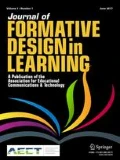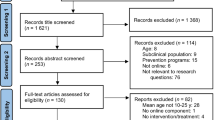Abstract
This case study discusses the design, development, and formative evaluation of Epilepsy Journey, an individually tailored, web-based intervention designed to address the unique executive functioning (EF) needs of adolescents with epilepsy. This intervention was designed through a three-phase iterative, patient-centered participatory action research process. First, a front-end analysis was completed to identify the unique needs of adolescents with epilepsy and initial design ideas via focus groups. Second, a preliminary design of the intervention was developed from focus group results. Finally, we iteratively incorporated revisions and refinements based on patient-centered feedback collected during usability sessions. Findings based on usage analytics, user reports, and coded qualitative themes from usability sessions suggest that our iterative, patient-centered approach to design, development, and evaluation resulted in a visually appealing interactive and brief intervention that is both engaging and individually tailored to the needs of adolescents with epilepsy.



Similar content being viewed by others
References
Branch, R. M., & Kopcha, T. J. (2014). Instructional design models. In J. M. Spector, M. D. Merrill, J. Elen, & M. J. Bishop (Eds.), Handbook of research on educational communications and technology (pp. 77–87). New York: Springer.
Dick, W., & Carey, L. (1990). The systematic design of instruction (3rd ed.). New York: Harper-Collins.
Dumas, J. S., & Redish, J. C. (1993). A practical guide to usability testing. Norwood: Ablex Publishing Corporation.
Eason, K. (1988). Information technology and organisational change. London: Taylor & Francis.
Godwin-Jones, R. (2011). Emerging technologies: mobile apps for language learning. Language Learning & Technology, 15(2), 2–11.
Goggins, S., Schmidt, M., Guajardo, J., & Moore, J. (2011). 3D virtual worlds: assessing the experience and informing design. International Journal of Social and Organizational Dynamics in Information Technology, 1.
Gould, J. D., & Lewis, C. (1985). Designing for usability: key principles and what designers think. In R. Baecker, J. Grudin, W. Buxton, & S. Greenberg (Eds.), Readings in human-computer interaction, toward the year 2000 (pp. 528–547). New York: Morgan-Kaufman.
Hix, D., & Hartson, H. R. (1994). Developing user interfaces: ensuring usability through product and process. New York: John Wiley & Sons, Inc..
Jackson, D. C., Dabbs, K., Walker, N. M., Jones, J. E., Hsu, D. A., Stafstrom, C. E., et al. (2013). The neuropsychological and academic substrate of new/recent-onset epilepsies. The Journal of Pediatrics, 162(5), 1047–1053.e1. https://doi.org/10.1016/j.jpeds.2012.10.04.
Kerr, E. N., & Blackwell, M. C. (2015). Near-transfer effects following working memory intervention (Cogmed) in children with symptomatic epilepsy: an open randomized clinical trial. Epilepsia, 56(11), 1784–1792. https://doi.org/10.1111/epi.13195.
Kindon, S., Pain, R., & Kesby, M. (2007). Participatory action research: origins, approaches and methods. In S. Kindon, R. Pain, & M. Kesby (Eds.), Participatory action research approaches and methods: connecting people, participation and place (pp. 9–18). London: Routledge.
Krug, S. (2010). Rocket surgery made easy: the do-it yourself guide to finding and fixing usability problems. Canada: New Riders.
Lezak, M., Howieson, D., & Loring, D. (2004). Neuropsychological assessment. Oxford, UK: Oxford University Press.
McIntyre, A. (2007). Participatory action research. New York: Sage.
MacAllister, W. S., Vasserman, M., Rosenthal, J., & Sherman, E. (2014). Attention and executive functions in children with epilepsy: what, why, and what to do. Applied neuropsychology: Child, 3(3), 215–225.
Nielsen, J. (1994a). Usability engineering. Boston: AP Professional.
Nielsen, J. (1994b). Usability inspection methods. In Conference companion on Human factors in computing systems (pp. 413–414). ACM. Retrieved from http://dl.acm.org/citation.cfm?id=260531
Norman, D. (1988). Design of everyday things. New York, NY: Currency Doubleday.
Piccinelli, P., Beghi, E., Borgatti, R., Ferri, M., Giordano, L., Romeo, A., et al. (2010). Neuropsychological and behavioural aspects in children and adolescents with idiopathic epilepsy at diagnosis and after 12 months of treatment. Seizure, 19(9), 540–546. https://doi.org/10.1016/j.seizure.2010.07.014.
Saroyan, A. (1992). Differences in expert practice: a case from formative evaluation. Instructional Science, 21(6), 451–472.
Shackel, B. (1991). Usability—context, framework, definition, design and evaluation. In B. Shackel & S. Richardson (Eds.), Human factors for informatics usability (pp. 21–37). Cambridge: Cambridge University Press.
Usage of content management systems for websites. (2017). Retrieved from https://w3techs.com/technologies/overview/content_management/all/
Wade, S. L., Carey, J., & Wolfe, C. R. (2006). An online family intervention to reduce parental distress following pediatric brain injury. Journal of Consulting and Clinical Psychology, 74(3), 445.
Wade, S. L., Stancin, T., Kirkwood, M., Brown, T. M., McMullen, K. M., & Taylor, H. G. (2014). Counselor-assisted problem solving (CAPS) improves behavioral outcomes in older adolescents with complicated mild to severe TBI. Journal of Head Trauma Rehabilitation, 29(3), 198–207. https://doi.org/10.1097/HTR.0b013e31828f9fe8.
Wade, S. L., Walz, N. C., Carey, J., Williams, K. M., Cass, J., Herren, L., & Yeates, K. O. (2010). A randomized trial of teen online problem solving for improving executive function deficits following pediatric traumatic brain injury. The Journal of Head Trauma Rehabilitation, 25(6), 409–415.
Worthen, B. R., & Sanders, J. R. (1987). Educational evaluation: alternative approaches and practical guidelines. London, England: Longman Pub Group.
Author information
Authors and Affiliations
Corresponding author
Ethics declarations
Conflict of Interest
On behalf of all authors, the corresponding author states that there is no conflict of interest.
Rights and permissions
About this article
Cite this article
Glaser, N.J., Schmidt, M., Wade, S.L. et al. The Formative Design of Epilepsy Journey: a Web-Based Executive Functioning Intervention for Adolescents with Epilepsy. J Form Des Learn 1, 126–135 (2017). https://doi.org/10.1007/s41686-017-0011-3
Published:
Issue Date:
DOI: https://doi.org/10.1007/s41686-017-0011-3




